
The hardware and bandwidth for this mirror is donated by dogado GmbH, the Webhosting and Full Service-Cloud Provider. Check out our Wordpress Tutorial.
If you wish to report a bug, or if you are interested in having us mirror your free-software or open-source project, please feel free to contact us at mirror[@]dogado.de.
The FastQC, written by Simon Andrews at the Babraham Institute, is the most widely used sequence quality assessment tool for evaluating the raw reads from high throughput sequencing data.
It produces, for each sample, an html report and a ‘zip’ file, which contains a file called fastqc_data.txt and summary.txt.
If you have hundreds of samples, you’re not going to open up each HTML page. You need some way of looking at these data in aggregate.
The fastqcr R package provides helper functions to easily and automatically parse, aggregate and analyze FastQC reports for large numbers of samples.
Additionally, the fastqcr package provides a convenient solution for building a multi-QC report and a one-sample FastQC report with the result interpretations. The online documentation is available at: https://rpkgs.datanovia.com/fastqcr/.
Examples of QC reports, generated automatically by the fastqcr R package, include:
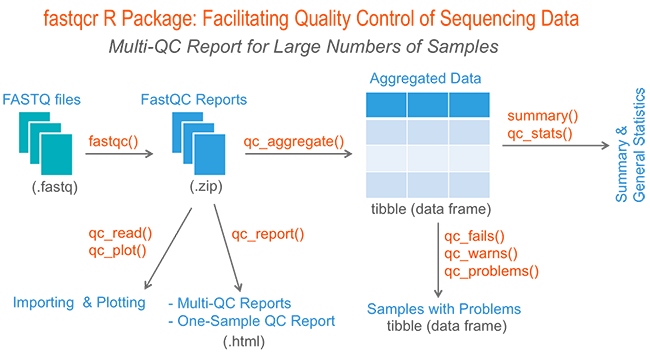
install.packages("fastqcr")if(!require(devtools)) install.packages("devtools")
devtools::install_github("kassambara/fastqcr")library("fastqcr")library(fastqcr)
# Aggregating Multiple FastQC Reports into a Data Frame
#%%%%%%%%%%%%%%%%%%%%%%%%%%%%%%%%%%%%%%%%%%%%%%%%%%%%%
# Demo QC directory containing zipped FASTQC reports
qc.dir <- system.file("fastqc_results", package = "fastqcr")
qc <- qc_aggregate(qc.dir)
qc
# Inspecting QC Problems
#%%%%%%%%%%%%%%%%%%%%%%%%%%%%%%%%%%%%%%%%%%%%%%%%%%%%%
# See which modules failed in the most samples
qc_fails(qc, "module")
# Or, see which samples failed the most
qc_fails(qc, "sample")
# Building Multi QC Reports
#%%%%%%%%%%%%%%%%%%%%%%%%%%%%%%%%%%%%%%%%%%%%%%%%%%%%%
qc_report(qc.dir, result.file = "multi-qc-report" )
# Building One-Sample QC Reports (+ Interpretation)
#%%%%%%%%%%%%%%%%%%%%%%%%%%%%%%%%%%%%%%%%%%%%%%%%%%%%%
qc.file <- system.file("fastqc_results", "S1_fastqc.zip", package = "fastqcr")
qc_report(qc.file, result.file = "one-sample-report",
interpret = TRUE)1) Installing and Running FastQC
fastqc_install(): Install the latest version of FastQC tool on Unix systems (MAC OSX and Linux)
fastqc(): Run the FastQC tool from R.
2) Aggregating and Summarizing Multiple FastQC Reports
qc <- qc_aggregate(): Aggregate multiple FastQC reports into a data frame.
summary(qc): Generates a summary of qc_aggregate.
qc_stats(qc): General statistics of FastQC reports.
3) Inspecting Problems
qc_fails(qc): Displays samples or modules that failed.
qc_warns(qc): Displays samples or modules that warned.
qc_problems(qc): Union of qc_fails() and qc_warns(). Display which samples or modules that failed or warned.
4) Importing and Plotting FastQC Reports
qc_read(): Read FastQC data into R.
qc_plot(qc): Plot FastQC data
5) Building One-Sample and Multi-QC Reports
6) Others
You can install automatically the FastQC tool from R as follow:
fastqc_install()The supported file formats by FastQC include:
Suppose that your working directory is organized as follow:
where, FASTQ is the directory containing your FASTQ files, for which you want to perform the quality control check.
To run FastQC from R, type this:
fastqc(fq.dir = "~/Documents/FASTQ", # FASTQ files directory
qc.dir = "~/Documents/FASTQC", # Results direcory
threads = 4 # Number of threads
)For each sample, FastQC performs a series of tests called analysis modules.
These modules include:
The interpretation of these modules are provided in the official documentation of the FastQC tool.
Here, we provide an R function qc_aggregate() to walk the FastQC result directory, find all the FASTQC zipped output folders, read the fastqc_data.txt and the summary.txt files, and aggregate the information into a data frame.
In the example below, we’ll use a demo FastQC output directory available in the fastqcr package.
library(fastqcr)
# Demo QC dir
qc.dir <- system.file("fastqc_results", package = "fastqcr")
qc.dir
# [1] "/Users/kassambara/Library/R/3.6/library/fastqcr/fastqc_results"
# List of files in the directory
list.files(qc.dir)
# [1] "S1_fastqc.zip" "S2_fastqc.zip" "S3_fastqc.zip" "S4_fastqc.zip"
# [5] "S5_fastqc.zip"The demo QC directory contains five zipped folders corresponding to the FastQC output for 5 samples.
Aggregating FastQC reports:
qc <- qc_aggregate(qc.dir)
qcThe aggregated report looks like this:
| sample | module | status | tot.seq | seq.length | pct.gc | pct.dup |
|---|---|---|---|---|---|---|
| S2 | Per tile sequence quality | PASS | 50299587 | 35-76 | 48 | 15.70 |
| S1 | Sequence Length Distribution | WARN | 50299587 | 35-76 | 48 | 17.24 |
| S3 | Per sequence quality scores | PASS | 67255341 | 35-76 | 49 | 22.14 |
| S3 | Per base sequence quality | PASS | 67255341 | 35-76 | 49 | 22.14 |
| S2 | Per sequence GC content | WARN | 50299587 | 35-76 | 48 | 15.70 |
| S5 | Sequence Duplication Levels | PASS | 65011962 | 35-76 | 48 | 18.15 |
| S1 | Per base N content | PASS | 50299587 | 35-76 | 48 | 17.24 |
| S5 | Basic Statistics | PASS | 65011962 | 35-76 | 48 | 18.15 |
| S2 | Per sequence quality scores | PASS | 50299587 | 35-76 | 48 | 15.70 |
| S1 | Per base sequence content | FAIL | 50299587 | 35-76 | 48 | 17.24 |
Column names:
The table shows, for each sample, the names of tested FastQC modules, the status of the test, as well as, some general statistics including the number of reads, the length of reads, the percentage of GC content and the percentage of duplicate reads.
Once you have the aggregated data you can use the dplyr package to easily inspect modules that failed or warned in samples. For example, the following R code shows samples with warnings and/or failures:
library(dplyr)
qc %>%
select(sample, module, status) %>%
filter(status %in% c("WARN", "FAIL")) %>%
arrange(sample)
# # A tibble: 15 × 3
# sample module status
# <chr> <chr> <chr>
# 1 S1 Per base sequence content FAIL
# 2 S1 Per sequence GC content WARN
# 3 S1 Sequence Length Distribution WARN
# 4 S2 Per base sequence content FAIL
# 5 S2 Per sequence GC content WARN
# 6 S2 Sequence Length Distribution WARN
# 7 S3 Per base sequence content FAIL
# 8 S3 Per sequence GC content FAIL
# 9 S3 Sequence Length Distribution WARN
# 10 S4 Per base sequence content FAIL
# 11 S4 Per sequence GC content FAIL
# 12 S4 Sequence Length Distribution WARN
# 13 S5 Per base sequence content FAIL
# 14 S5 Per sequence GC content WARN
# 15 S5 Sequence Length Distribution WARN
In the next section, we’ll describe some easy-to-use functions, available in the fastqcr package, for analyzing the aggregated data.
We start by presenting a summary and general statistics of the aggregated data.
# Summary of qc
summary(qc)
# # A tibble: 12 × 7
# # Groups: module [12]
# module nb_samples nb_fail nb_pass nb_warn failed warned
# <chr> <dbl> <dbl> <dbl> <dbl> <chr> <chr>
# 1 Adapter Content 5 0 5 0 <NA> <NA>
# 2 Basic Statistics 5 0 5 0 <NA> <NA>
# 3 Kmer Content 5 0 5 0 <NA> <NA>
# 4 Overrepresented sequences 5 0 5 0 <NA> <NA>
# 5 Per base N content 5 0 5 0 <NA> <NA>
# 6 Per base sequence content 5 5 0 0 S1, S… <NA>
# 7 Per base sequence quality 5 0 5 0 <NA> <NA>
# 8 Per sequence GC content 5 2 0 3 S3, S4 S1, S…
# 9 Per sequence quality scores 5 0 5 0 <NA> <NA>
# 10 Per tile sequence quality 5 0 5 0 <NA> <NA>
# 11 Sequence Duplication Levels 5 0 5 0 <NA> <NA>
# 12 Sequence Length Distribution 5 0 0 5 <NA> S1, S…Column names:
The table shows, for each FastQC module, the number and the name of samples that failed or warned.
qc_stats(qc)
# # A tibble: 5 × 5
# sample pct.dup pct.gc tot.seq seq.length
# <chr> <dbl> <dbl> <chr> <chr>
# 1 S1 17.2 48 50299587 35-76
# 2 S2 15.7 48 50299587 35-76
# 3 S3 22.1 49 67255341 35-76
# 4 S4 19.9 49 67255341 35-76
# 5 S5 18.2 48 65011962 35-76Column names:
The table shows, for each sample, some general statistics such as the total number of reads, the length of reads, the percentage of GC content and the percentage of duplicate reads
Once you’ve got this aggregated data, it’s easy to figure out what (if anything) is wrong with your data.
1) R functions. You can inspect problems per either modules or samples using the following R functions:
2) Input data: aggregated data from qc_aggregate()
3) Output data: Returns samples or FastQC modules with failures or warnings. By default, these functions return a compact output format. If you want a stretched format, specify the argument compact = FALSE.
The format and the interpretation of the outputs depend on the additional argument element, which value is one of c(“sample”, “module”).
# See which module failed in the most samples
qc_fails(qc, "module")
# # A tibble: 2 × 3
# module nb_problems sample
# <chr> <int> <chr>
# 1 Per base sequence content 5 S1, S2, S3, S4, S5
# 2 Per sequence GC content 2 S3, S4
For each module, the number of problems (failures) and the name of samples, that failed, are shown.
# See which module warned in the most samples
qc_warns(qc, "module")
# # A tibble: 2 × 3
# module nb_problems sample
# <chr> <int> <chr>
# 1 Sequence Length Distribution 5 S1, S2, S3, S4, S5
# 2 Per sequence GC content 3 S1, S2, S5# See which modules failed or warned.
qc_problems(qc, "module")
# # A tibble: 3 × 3
# module nb_problems sample
# <chr> <int> <chr>
# 1 Per base sequence content 5 S1, S2, S3, S4, S5
# 2 Per sequence GC content 5 S1, S2, S3, S4, S5
# 3 Sequence Length Distribution 5 S1, S2, S3, S4, S5The output above is in a compact format. For a stretched format, type this:
qc_problems(qc, "module", compact = FALSE)
# # A tibble: 15 × 4
# module nb_problems sample status
# <chr> <int> <chr> <chr>
# 1 Per base sequence content 5 S1 FAIL
# 2 Per base sequence content 5 S2 FAIL
# 3 Per base sequence content 5 S3 FAIL
# 4 Per base sequence content 5 S4 FAIL
# 5 Per base sequence content 5 S5 FAIL
# 6 Per sequence GC content 5 S3 FAIL
# 7 Per sequence GC content 5 S4 FAIL
# 8 Per sequence GC content 5 S1 WARN
# 9 Per sequence GC content 5 S2 WARN
# 10 Per sequence GC content 5 S5 WARN
# 11 Sequence Length Distribution 5 S1 WARN
# 12 Sequence Length Distribution 5 S2 WARN
# 13 Sequence Length Distribution 5 S3 WARN
# 14 Sequence Length Distribution 5 S4 WARN
# 15 Sequence Length Distribution 5 S5 WARN
In the the stretched format each row correspond to a unique sample. Additionally, the status of each module is specified.
It’s also possible to display problems for one or more specified modules. For example,
qc_problems(qc, "module", name = "Per sequence GC content")
# # A tibble: 5 × 4
# module nb_problems sample status
# <chr> <int> <chr> <chr>
# 1 Per sequence GC content 5 S3 FAIL
# 2 Per sequence GC content 5 S4 FAIL
# 3 Per sequence GC content 5 S1 WARN
# 4 Per sequence GC content 5 S2 WARN
# 5 Per sequence GC content 5 S5 WARN
Note that, partial matching of name is allowed. For example, name = “Per sequence GC content” equates to name = “GC content”.
qc_problems(qc, "module", name = "GC content")# See which samples had one or more failed modules
qc_fails(qc, "sample")
# # A tibble: 5 × 3
# sample nb_problems module
# <chr> <int> <chr>
# 1 S3 2 Per base sequence content, Per sequence GC content
# 2 S4 2 Per base sequence content, Per sequence GC content
# 3 S1 1 Per base sequence content
# 4 S2 1 Per base sequence content
# 5 S5 1 Per base sequence content
For each sample, the number of problems (failures) and the name of modules, that failed, are shown.
# See which samples had one or more module with failure or warning
qc_problems(qc, "sample", compact = FALSE)
# # A tibble: 15 × 4
# sample nb_problems module status
# <chr> <int> <chr> <chr>
# 1 S1 3 Per base sequence content FAIL
# 2 S1 3 Per sequence GC content WARN
# 3 S1 3 Sequence Length Distribution WARN
# 4 S2 3 Per base sequence content FAIL
# 5 S2 3 Per sequence GC content WARN
# 6 S2 3 Sequence Length Distribution WARN
# 7 S3 3 Per base sequence content FAIL
# 8 S3 3 Per sequence GC content FAIL
# 9 S3 3 Sequence Length Distribution WARN
# 10 S4 3 Per base sequence content FAIL
# 11 S4 3 Per sequence GC content FAIL
# 12 S4 3 Sequence Length Distribution WARN
# 13 S5 3 Per base sequence content FAIL
# 14 S5 3 Per sequence GC content WARN
# 15 S5 3 Sequence Length Distribution WARNTo specify the name of a sample of interest, type this:
qc_problems(qc, "sample", name = "S1")
# # A tibble: 3 × 4
# sample nb_problems module status
# <chr> <int> <chr> <chr>
# 1 S1 3 Per base sequence content FAIL
# 2 S1 3 Per sequence GC content WARN
# 3 S1 3 Sequence Length Distribution WARNThe function qc_report() can be used to build a report of FastQC outputs. It creates an HTML file containing FastQC reports of one or multiple samples.
Inputs can be either a directory containing multiple FastQC reports or a single sample FastQC report.
We’ll build a multi-qc report for the following demo QC directory:
# Demo QC Directory
qc.dir <- system.file("fastqc_results", package = "fastqcr")
qc.dir
# [1] "/Users/kassambara/Library/R/3.6/library/fastqcr/fastqc_results"# Build a report
qc_report(qc.dir, result.file = "~/Desktop/multi-qc-result",
experiment = "Exome sequencing of colon cancer cell lines")
An example of report is available at: <a href= “https://rpkgs.datanovia.com/fastqcr/qc-reports/fastqcr-multi-qc-report.html”, target = “_blank”> fastqcr multi-qc report
We’ll build a report for the following demo QC file:
qc.file <- system.file("fastqc_results", "S1_fastqc.zip", package = "fastqcr")
qc.file
# [1] "/Users/kassambara/Library/R/3.6/library/fastqcr/fastqc_results/S1_fastqc.zip" qc_report(qc.file, result.file = "one-sample-report-with-interpretation",
interpret = TRUE)
An example of report is available at: <a href= “https://rpkgs.datanovia.com/fastqcr/qc-reports/sample-qc-report-interpretation.html”, target = “_blank”> One sample QC report with interpretation
qc_report(qc.file, result.file = "one-sample-report",
interpret = FALSE)
An example of report is available at: <a href= “https://rpkgs.datanovia.com/fastqcr/qc-reports/sample-qc-report-without-interpretation.html”, target = “_blank”> One sample QC report without interpretation
We’ll visualize the output for sample 1:
# Demo file
qc.file <- system.file("fastqc_results", "S1_fastqc.zip", package = "fastqcr")
qc.file
# [1] "/Users/kassambara/Library/R/3.6/library/fastqcr/fastqc_results/S1_fastqc.zip"We start by reading the output using the function qc_read(), which returns a list of tibbles containing the data for specified modules:
# Read all modules
qc <- qc_read(qc.file)
# Elements contained in the qc object
names(qc)
# [1] "summary" "basic_statistics"
# [3] "per_base_sequence_quality" "per_tile_sequence_quality"
# [5] "per_sequence_quality_scores" "per_base_sequence_content"
# [7] "per_sequence_gc_content" "per_base_n_content"
# [9] "sequence_length_distribution" "sequence_duplication_levels"
# [11] "overrepresented_sequences" "adapter_content"
# [13] "kmer_content" "total_deduplicated_percentage"The function qc_plot() is used to visualized the data of a specified module. Allowed values for the argument modules include one or the combination of:
qc_plot(qc, "Per sequence GC content")
qc_plot(qc, "Per base sequence quality")
qc_plot(qc, "Per sequence quality scores")
qc_plot(qc, "Per base sequence content")
qc_plot(qc, "Sequence duplication levels")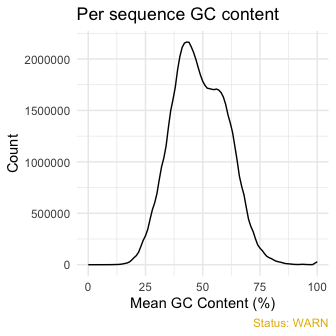
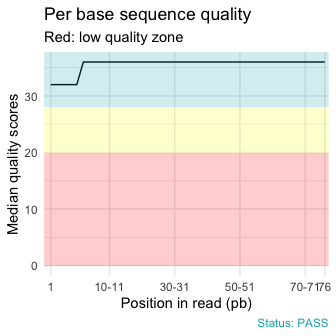
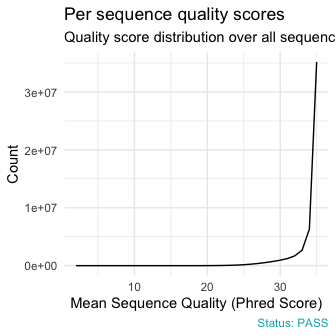
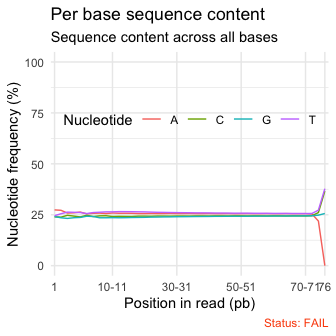
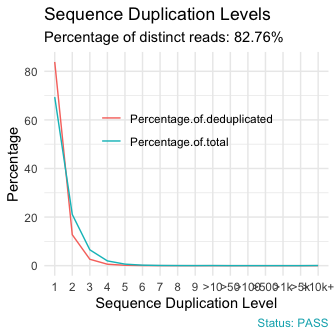
These binaries (installable software) and packages are in development.
They may not be fully stable and should be used with caution. We make no claims about them.
Health stats visible at Monitor.